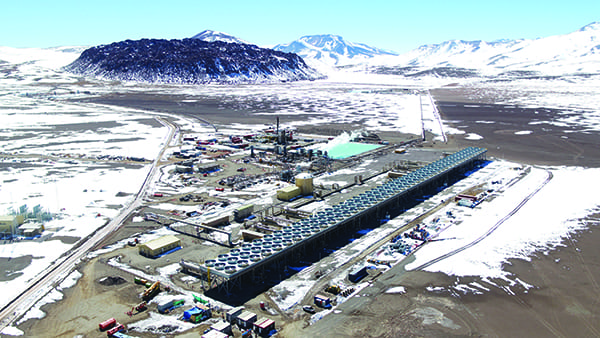Cerro Pabellón: TAKING GEOTHERMAL POWER TO NEW HEIGHTS
South America’s first and only geothermal power plant, the 48-MW Cerro Pabellón project, sits at an elevation of 4,500 meters above sea level in Chile’s harsh and remote Atacama Desert. Building and operating a plant in these extreme site conditions was no easy task. While it required keen organization and project innovation, it came online, on budget, and it has broken new ground for the continent that is rich in geothermal potential.
 Why would anyone build a power project at an elevation of 4,500 meters (m) above sea level in the Atacama Desert? The wind-sculpted region that is sandwiched between the Pacific Ocean and the Andes Mountains in northern Chile is bone dry, and its temperatures vary to such extremes that only cacti and resilient grasses can survive. At an altitude of 4,500 m—far more than the human threshold for altitude sickness—the desert becomes even more brutal, characterized by a blistering sun by day, and strong winds, snow, and temperatures that often plummet to –22F (–30C) at night.
Why would anyone build a power project at an elevation of 4,500 meters (m) above sea level in the Atacama Desert? The wind-sculpted region that is sandwiched between the Pacific Ocean and the Andes Mountains in northern Chile is bone dry, and its temperatures vary to such extremes that only cacti and resilient grasses can survive. At an altitude of 4,500 m—far more than the human threshold for altitude sickness—the desert becomes even more brutal, characterized by a blistering sun by day, and strong winds, snow, and temperatures that often plummet to –22F (–30C) at night.
According to Guido Cappetti, general manager of Geotermica del Norte S.A. (GDN) who oversaw development and construction of the 48-MW Cerro Pabellón geothermal project so high up in the desert, the answer is multifaceted.
First, Chile is located in the Earth’s largest volcanic chain. Although the country has a sizable geothermal potential of more than 3,600 MW, geothermal power had never been a commercial venture in the entire continent of South America before GDN launched operations of the Cerro Pabellón project in June 2017.
Second, GDN is a joint venture between Chilean state-owned Empresa Nacional del Petróleo (ENAP), a state-owned hydrocarbon company that holds 15.37% of the project, and Enel Green Power, which holds the remaining 84.63%. While ENAP originally held a 49% share of the GDN venture, Enel Green Power, a subsidiary of Italian energy giant ENEL, took on a larger share to pursue the promising project, armed with vast geothermal experience and the necessary expertise, which it developed from years of building and operating geothermal power plants in Italy and in the U.S.
Third, the project, which is sited on an Andean plateau in the remote Ollagüe district of the Antofagasta region, was intended to supply power to the Chilean Northern Interconnected System—an area whose supply has mostly relied on coal, natural gas, diesel, and fuel oil for power—and benefit the region environmentally and economically. (In late 2017, the Chilean government interconnected the northern power grid to the central power grid, forming the National Electric System.)
And finally, but as crucially, the project promised to create jobs for local communities.
The Project Gains Steam
According to Cappetti, an industry professional with 40 years of experience in the geothermal industry, the decision to forge on with Cerro Pabellón was made after four geothermal exploration wells drilled between 2009 and 2010 made it possible to verify the presence of a geothermal reservoir with high values of temperature and permeability. The wells showed “great promise” for the development phase, he said.

